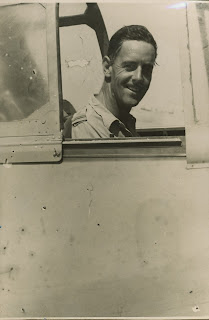In April 2002, my husband
David and I were flipping through an auction catalogue and came across an item
that sparked our interest. The lot included letters and photos relating to
Group Captain Clive Robertson Caldwell DSO, DFC and Bar, Polish Cross of
Valour, and we decided to bid. The letters were written by Clive Caldwell to
his friend Ernest Richardson Slade-Slade. Slade, as he was known, and Caldwell
were friends long before the war and their friendship continued until Caldwell
died. In these letters, Caldwell told of his experiences with 250 Squadron RAF.
One letter, written in early July 1941, referred to a number of actions during
which Caldwell obtained his first official victories. The other letter was
written just after Christmas 1941, and dealt with some of his experiences in
the latter part of that year. Once I read the letters, I knew that I wanted to
find out more about Caldwell. I presented a talk to my local military history
group and, afterwards, the president suggested that ‘there’s a book there’. The
seed had been planted. I next presented a paper at a conference. It was well received;
the seed took root. The more I read and heard about Caldwell, the more my
admiration and respect grew and I wanted others to learn about his contribution
to the war effort. I continued my research and over the next couple of years I
wrote a number of papers for the Society’s journal, but with the goal of a
biography in mind. Just over four years after that desultory flip through the auction
catalogue, Clive Caldwell Air Ace—my
first book—was published.
Three of the photos from the collection (all included in Clive Caldwell Air Ace)
Caldwell in the cockpit of his Tomahawk after he was
shot at on 29 August 1941 demonstrating where he was sitting in relation to the
bullet impact. He told Slade that ‘the canopy is in the same position as it was
during the “do”. On the far side just behind my head you can see where a few
bullets came through and scored a near miss. Another similar burst of about
twice the number came through the top, but … was a failure owing to sun glare.
They took the earpiece off my helmet. A number of shrapnel holes from the 20mm
shells that hit the wings can be seen in the side of the cockpit…’
Caldwell in front of his Tomahawk after he was shot at
on 29 August 1941. For his actions
on this day, he was awarded the Distinguished Flying Cross. This and subsequent photos illustrating this incident were taken
the following day. Caldwell told his friend Slade that ‘the
wings will give you an idea of what an ME 109 can do with 20mm cannon. A decent
burst of some 40 odd bullets is clustered where the oil stains are. The most of
it (bullets) are in the other side and some underneath. The holes in myself are
at the moment covered with plaster only for the snap which was taken for Jean’s
benefit but anyhow I wasn’t hurt worth a damn. The tyre in the starboard side
as you see was hit also by bullets and a bit flat. The wing on the other side
caught most bullets and one shell, the cowlings are well peppered, but like the
wing this side doesn’t show it at this distance.’

‘Here’s a view of the wing as the pilot sees it and shows the effect of the 109’s 20mm guns and a few bullet holes. Wing on other side caught decent dose of bullets and so did port side of cockpit and floor’, wrote Caldwell.



No comments:
Post a Comment